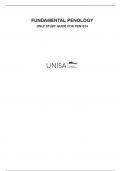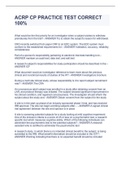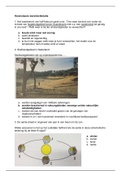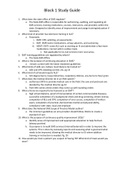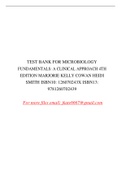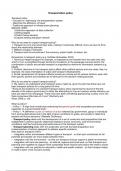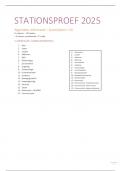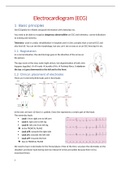Motivation & Performance
Lecture 1
• Performance: the action or process of performing a specific task or function
• Hedonic axiom: organisms work to avoid aversive outcomes and to attain
pleasant outcomes
• Why do people do what they do?
1. Assumption of determinism: every event is an unavoidable and
necessary consequence of prior circumstances (domino pattern)
a. Does not mean that the world can be understood and explained by
humans (Dennett)
b. Even a very simple world can be unpredictable -> reality is much
more complex
c. Motivation science: if we understand the causes of behavior, we can
predict behavior
2. The mind-body problem:
a. Material world: body = tangible, can be studied
b. immaterial world: mind = intangible
c. how connected? -> Descartes interactionist dualism
i. viewpoint: mind controls body -> influential but logical
problematic
ii. very relevant for motivation science bc you need to know
where to look when looking for the causes of behavior
d. option 1: mind only
i. sensory input -> mind -> response (behavior)
ii. solipsism: “I am the only human being that actually exist,
everything else is a part of my imagination”
e. option 2: body only
i. sensory input -> brain -> response (behavior)
f. option 3: sloppy mix of biology and psychology
g. option 4: materialistic monism
i. mind exists, but more in construction of the brain
ii. you’re an agent of your own existence
1
,• defining motivation is difficult
• Motivation: a process that energizes, directs and regulates behavior
• Hedonic continuum: but what is pleasant and what is aversive?
o This assumes a neutral point, but in reality, a neutral point is difficult to
pinpoint
• Ways to establish the positivity of an outcome
o Preferences/choices
o Maximum effort (that one is prepared to exert for the outcome)
▪ Parasympathetic and sympathetic system
o Persistence
o Self-reporting
• Need: necessary condition for well-being, innate property of an organism
o Homeostasis: feedback loop for eating
▪ 1. Eating -> Small intestine produces CCK hormone -> brain
detects and regulates -> eating behavior
▪ 2. Eating -> detection of oxidation speed in liver -> detection of
free fatty acids in hypothalamus -> eating behavior
▪ 3. Feed-forward loop: anticipating
• Food -> detection of increased glucose levels in blood
(pancreas) triggers insulin -> inhibition of glucose
production in liver + speed up transport of glucose to cells
for storage and usage -> pancreas
▪ Systems (1,2,3) only active when people are hungry
▪ Humans prevent disturbances in homeostasis
• By eating when there is food
• By eating as function of social habits
• Visual cues (materialistic monism)
o Study: A (fatty food), B (non-fatty foods), C (all food) all compared to
screwdrivers
▪ A: homeostatic part activated by hypothalamus, and activated by
striatum (reward)
▪ B: no activity
▪ C: some activity but not as much as A
2
,o Classical conditioning:
▪ 1. Acquisition: CS + UCS
▪ 2. Extinction: CS only (decline of CR)
▪ 3. Generalization: other (neutral)
stimuli that resemble CS also can cause
CR
▪ 4. Discrimination: ability to differentiate
between CS and other stimuli which
have not been paired with UCS
▪ 5. Spontaneous recovery: didnt see stimulus for a while and
when you see it you react at it again (but not as much)
▪ Examples:
• aversion to tastes: CS (Salmon) -> UCS (bacteria) ->
UCR (sick)
• CS (mom comes home; mom hanging coat on rack) ->
UCS (parents fighting) -> UCR (sadness and fear kids)
• Principle of blocking: humans tend to block redundant
CS (so hanging coat on rack)
▪ Treatments
• 1. systematic desensitization: reduce fear responses
o 1. Relaxation phase
o 2. Create fearful situation (based on fear hierarchy)
o 3. Being relaxed in fearful situations
• 2. Aversion therapy: nail biting; alcohol abuse
o Other physiological needs: food, drinking, temperature, sex
▪ Characterized by negative feedback loop?
• Drinking and temperature -> yes
• Eating -> yes, as last resort
• Sex -> no
3
, Lecture 2
• Relationship between physiological and psychological needs: Maslow’s self-
actualization pyramid (physiological, safety, love, self-esteem, self-
actualization)
• Self-determination theory: all needs are active at the same time
o Types of needs:
▪ physiological (food, water, sex)
▪ psychological (autonomy, competence, relatedness)
▪ social (achievement, affiliation, power)
o Psychological needs: an inherent source of motivation that generates
the desire to interact with the environment to as to advance personal
growth, social development, and psychological well-being
▪ Autonomy: need to experience self-direction and personal
endorsement in the initiation and regulation of one’s behavior
• 1. Internal perceived locus of causality: that you made
it happen, that you aren’t the victim
• 2. Volition (feeling free): unpressured willingness to
engage in an activity
• 3. Perceived choice over one’s actions
• People who feel more autonomous, competent and
related: have more intrinsic motivation
• Autonomy-supportive style vs controlling
o Nurture inner motivational resources vs
incentives/rewards
o Rely on informational, noncontrolling language vs
directives
o Communicate value and provide rationales vs
deadlines
o Acknowledge and accept others’ expressions of
negative affect vs compliance requests
• Study children painting: more enjoyment, free choice
behavior, creativity, technical goodness and quality in
autonomy-supportive way
4
Lecture 1
• Performance: the action or process of performing a specific task or function
• Hedonic axiom: organisms work to avoid aversive outcomes and to attain
pleasant outcomes
• Why do people do what they do?
1. Assumption of determinism: every event is an unavoidable and
necessary consequence of prior circumstances (domino pattern)
a. Does not mean that the world can be understood and explained by
humans (Dennett)
b. Even a very simple world can be unpredictable -> reality is much
more complex
c. Motivation science: if we understand the causes of behavior, we can
predict behavior
2. The mind-body problem:
a. Material world: body = tangible, can be studied
b. immaterial world: mind = intangible
c. how connected? -> Descartes interactionist dualism
i. viewpoint: mind controls body -> influential but logical
problematic
ii. very relevant for motivation science bc you need to know
where to look when looking for the causes of behavior
d. option 1: mind only
i. sensory input -> mind -> response (behavior)
ii. solipsism: “I am the only human being that actually exist,
everything else is a part of my imagination”
e. option 2: body only
i. sensory input -> brain -> response (behavior)
f. option 3: sloppy mix of biology and psychology
g. option 4: materialistic monism
i. mind exists, but more in construction of the brain
ii. you’re an agent of your own existence
1
,• defining motivation is difficult
• Motivation: a process that energizes, directs and regulates behavior
• Hedonic continuum: but what is pleasant and what is aversive?
o This assumes a neutral point, but in reality, a neutral point is difficult to
pinpoint
• Ways to establish the positivity of an outcome
o Preferences/choices
o Maximum effort (that one is prepared to exert for the outcome)
▪ Parasympathetic and sympathetic system
o Persistence
o Self-reporting
• Need: necessary condition for well-being, innate property of an organism
o Homeostasis: feedback loop for eating
▪ 1. Eating -> Small intestine produces CCK hormone -> brain
detects and regulates -> eating behavior
▪ 2. Eating -> detection of oxidation speed in liver -> detection of
free fatty acids in hypothalamus -> eating behavior
▪ 3. Feed-forward loop: anticipating
• Food -> detection of increased glucose levels in blood
(pancreas) triggers insulin -> inhibition of glucose
production in liver + speed up transport of glucose to cells
for storage and usage -> pancreas
▪ Systems (1,2,3) only active when people are hungry
▪ Humans prevent disturbances in homeostasis
• By eating when there is food
• By eating as function of social habits
• Visual cues (materialistic monism)
o Study: A (fatty food), B (non-fatty foods), C (all food) all compared to
screwdrivers
▪ A: homeostatic part activated by hypothalamus, and activated by
striatum (reward)
▪ B: no activity
▪ C: some activity but not as much as A
2
,o Classical conditioning:
▪ 1. Acquisition: CS + UCS
▪ 2. Extinction: CS only (decline of CR)
▪ 3. Generalization: other (neutral)
stimuli that resemble CS also can cause
CR
▪ 4. Discrimination: ability to differentiate
between CS and other stimuli which
have not been paired with UCS
▪ 5. Spontaneous recovery: didnt see stimulus for a while and
when you see it you react at it again (but not as much)
▪ Examples:
• aversion to tastes: CS (Salmon) -> UCS (bacteria) ->
UCR (sick)
• CS (mom comes home; mom hanging coat on rack) ->
UCS (parents fighting) -> UCR (sadness and fear kids)
• Principle of blocking: humans tend to block redundant
CS (so hanging coat on rack)
▪ Treatments
• 1. systematic desensitization: reduce fear responses
o 1. Relaxation phase
o 2. Create fearful situation (based on fear hierarchy)
o 3. Being relaxed in fearful situations
• 2. Aversion therapy: nail biting; alcohol abuse
o Other physiological needs: food, drinking, temperature, sex
▪ Characterized by negative feedback loop?
• Drinking and temperature -> yes
• Eating -> yes, as last resort
• Sex -> no
3
, Lecture 2
• Relationship between physiological and psychological needs: Maslow’s self-
actualization pyramid (physiological, safety, love, self-esteem, self-
actualization)
• Self-determination theory: all needs are active at the same time
o Types of needs:
▪ physiological (food, water, sex)
▪ psychological (autonomy, competence, relatedness)
▪ social (achievement, affiliation, power)
o Psychological needs: an inherent source of motivation that generates
the desire to interact with the environment to as to advance personal
growth, social development, and psychological well-being
▪ Autonomy: need to experience self-direction and personal
endorsement in the initiation and regulation of one’s behavior
• 1. Internal perceived locus of causality: that you made
it happen, that you aren’t the victim
• 2. Volition (feeling free): unpressured willingness to
engage in an activity
• 3. Perceived choice over one’s actions
• People who feel more autonomous, competent and
related: have more intrinsic motivation
• Autonomy-supportive style vs controlling
o Nurture inner motivational resources vs
incentives/rewards
o Rely on informational, noncontrolling language vs
directives
o Communicate value and provide rationales vs
deadlines
o Acknowledge and accept others’ expressions of
negative affect vs compliance requests
• Study children painting: more enjoyment, free choice
behavior, creativity, technical goodness and quality in
autonomy-supportive way
4


